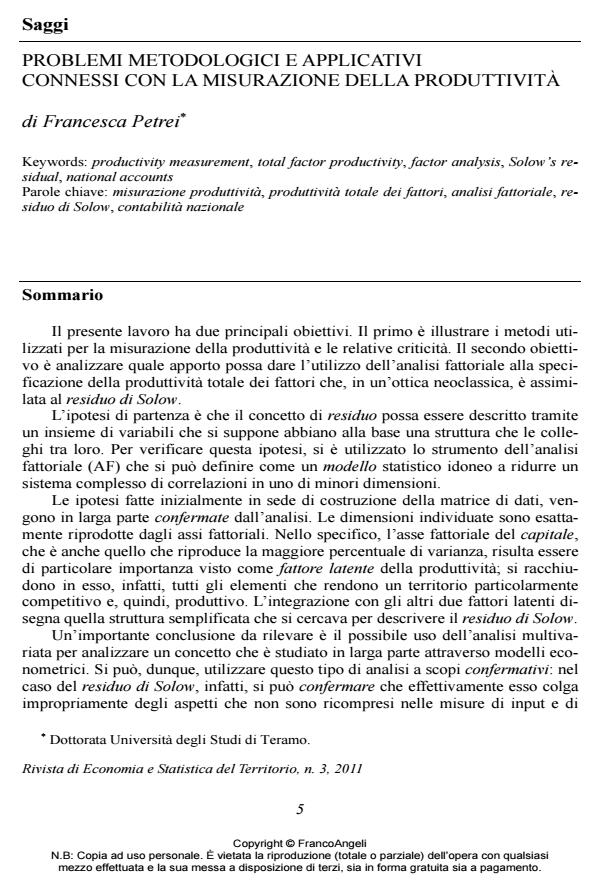Problemi metodologici e applicativi connessi con la misurazione della produttività
Journal title RIVISTA DI ECONOMIA E STATISTICA DEL TERRITORIO
Author/s Petrei Francesca
Publishing Year 2011 Issue 2011/3
Language Italian Pages 34 P. 5-38 File size 279 KB
DOI 10.3280/REST2011-003002
DOI is like a bar code for intellectual property: to have more infomation
click here
Below, you can see the article first page
If you want to buy this article in PDF format, you can do it, following the instructions to buy download credits

FrancoAngeli is member of Publishers International Linking Association, Inc (PILA), a not-for-profit association which run the CrossRef service enabling links to and from online scholarly content.
Methodological and applied problems of productivity measurement Objectives This paper has two main objectives. The first is to illustrate the methods used to measure productivity and their methodological problems. The second is to study what contribution the use of factor analysis can make to the measurement of total factor productivity, which, from a neoclassic perspective, is assimilated as “Solow’s residual”. Methods and Results The assumption is that the concept of residue can be described by a set of variables which are supposed to have an underlying structure linking them together. To test this hypothesis, we used the tool of factor analysis (FA) which can be described as a useful statistical model for reducing a complex system of correlations into a smaller one. The assumptions made initially in the construction of the data matrix, are largely confirmed by analysis. The dimensions identified are exactly reproduced by the factorial axes. Specifically, the capital of the factorial axis, which is also the one which explains the greatest percentage of variance, is of particular importance as a latent factor of productivity; it, in fact, includes all those elements which make an area particularly competitive and, therefore, productive. The integration with the other two latent factors shows the simplified structure which was sought in order to describe the Solow residual. Conclusions One important conclusion is the possible use of multivariate analysis to analyze a concept which is generally studied with econometric models. We can therefore use this type of analysis for confirmatory purposes: in the case of the Solow residual, in fact, we can confirm that it actually improperly identifies aspects which are not included in the input and output measures, and these aspects, mentioned by the literature or by econometric determinations, are found in the latent structure produced by factor analysis as determinants of productivity and, therefore, the growth of an economic system.
Keywords: Productivity measurement, total factor productivity, factor analysis, Solow’s residual, national accounts Parole chiave: misurazione produttività, produttività totale dei fattori, analisi fattoriale, residuo di Solow, contabilità nazionale
Jel codes: C82, D24, E13, O3, O47
Petrei Francesca, Problemi metodologici e applicativi connessi con la misurazione della produttività in "RIVISTA DI ECONOMIA E STATISTICA DEL TERRITORIO" 3/2011, pp 5-38, DOI: 10.3280/REST2011-003002